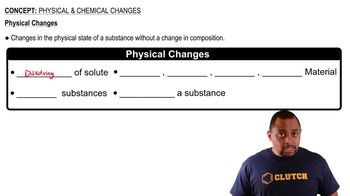Which of the following figures represents (b) a mixture of two elements, (More than one picture might fit each description.)
Which of the following diagrams represents a chemical change?
 Verified step by step guidance
Verified step by step guidance
Verified video answer for a similar problem:
Key Concepts
Chemical Change

Physical Change

Interpreting Diagrams of Chemical Processes

Which of the following figures represents (c) a pure compound, (More than one picture might fit each description.)
Which of the following figures represents (d) a mixture of an element and a compound? (More than one picture might fit each description.)
Musical instruments like trumpets and trombones are made from an alloy called brass. Brass is composed of copper and zinc atoms and appears homogeneous under an optical microscope. The approximate composition of most brass objects is a 2:1 ratio of copper to zinc atoms, but the exact ratio varies somewhat from one piece of brass to another. (a) Would you classify brass as an element, a compound, a homogeneous mixture, or a heterogeneous mixture?
Consider the two spheres shown here, one made of silver and the other of aluminum. (a) What is the mass of each sphere in kg?
Consider the two spheres shown here, one made of silver and the other of aluminum. (a) What is the mass of each sphere in kg?
